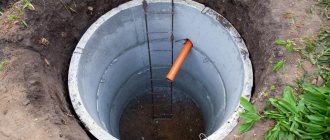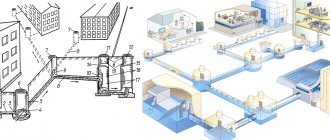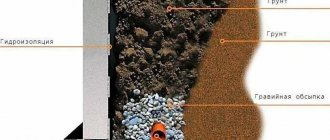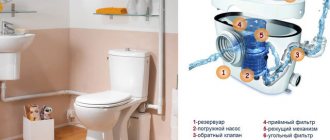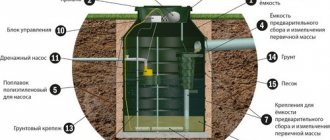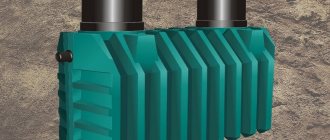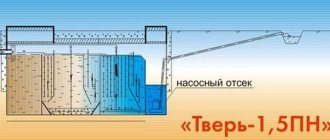The BioDeka autonomous sewer system effectively cleans household wastewater from harmful microorganisms and food particles, eliminating unpleasant odors. Installation of the station takes 2–3 hours. The operating principle of the BioDeka 5 septic tank is based on the characteristics of the life activity of aerobic bacteria. The water obtained as a result of purification can be used for:
- glaze;
- car washing;
- and other technical needs.
The performance of a septic tank does not depend on the volume of wastewater at different times of the day. The main advantages of the system are:
- environmental safety;
- no unpleasant odor;
- durability of the structure;
- competitive cost;
- resistance of the polymer tank to aggressive environments.
Proper operation of a septic tank requires the presence of a stable source of electricity, so for areas with frequent and prolonged interruptions in the supply of electricity, you will have to buy a generator or install an autonomous sewage system such as a bioseptic tank.
Construction of a BioDeka septic tank
Appearance of the septic tank
To find out how the BioDeka septic tank works, you should familiarize yourself with the design of this design. The case material is high-strength plastic, allowing the system to be operated in any climatic conditions. The body has a cylindrical shape with one welded seam, which increases the reliability and strength of the structure.
The device inside is equipped with a system of cameras, which are separated from each other by partitions. Cameras perform specific functions sequentially. The system is compact and requires virtually no maintenance. There is no need to build a special access road to the station. The pumped sludge is widely used as fertilizer for plants.
The main components of the BioDeka autonomous sewage system:
Internal structure of a septic tank
- primary settling tank;
- aeration tank chamber;
- stabilizing compartment;
- denitrification zone;
- secondary settling tank;
- aerator and airlift.
The autonomous sewage system is equipped with an emergency notification.
The principle of operation of a septic tank
The operation of the BioDeka station is based on the use of aerobic bacteria that perform biological wastewater treatment. The process of cleaning the sewerage system is carried out in stages:
- primary sedimentation - first of all, insoluble and heavy particles are separated;
- biological wastewater treatment;
- repeated settling, as a result of which activated sludge settles to the bottom of the chamber.
Technological process of the BioDeca installation
Mechanical cleaning
Each passage of wastewater through the chamber system is accompanied by a certain process. Wastewater, entering the first settling tank, with the help of aeration tanks installed in it, is broken down according to the size of the waste. When the chamber is filled above a predetermined level, the wastewater is automatically pumped by airlifts to the next compartment.
The cleaning technology incorporated into the Biodeka design is by far the most effective and has many advantages.
Biological treatment
At this stage, aerobic bacteria are involved and direct purification of the liquid occurs. The wastewater is clarified, and activated sludge is formed from the sediment. Beneficial microorganisms live and reproduce only in an oxygen-enriched liquid environment, so the process of supplying air to the system must be continuous. If it is violated for any reason, microorganisms begin to die within a few hours, and the quality of the outlet water will gradually deteriorate.
Operating principle of a biological treatment plant
The activated sludge is pumped into the stabilizing compartment, where it is blown off. Clarified wastewater from the aeration tank chamber is directed to the denitrification zone, where wastewater and prepared activated sludge are mixed.
Oxygen does not participate in this reaction. As a result of mixing, a biological film appears, which is removed using a pump.
Next comes the final stage of biological wastewater treatment. The water enters the second settling tank, where the sludge is pumped out with a pump.
What are the consequences of excess moisture in the soil?
You can see the results of this phenomenon yourself - trees and shrubs die. Why is this happening?
- the oxygen content in the soil decreases and the carbon dioxide content increases, which leads to disruption of air exchange processes, water regime and nutritional regime in the soil;
- oxygen starvation of the root-forming layer occurs, which leads to the death of plant roots;
- the supply of macro and microelements by plants (nitrogen, phosphorus, potassium, etc.) is disrupted, because excess water washes out mobile forms of elements from the soil, and they become unavailable for absorption;
- intensive breakdown of proteins occurs and, accordingly, the processes of decay are activated.
Plants can tell you at what level groundwater lies
Take a close look at the flora of your area. The species inhabiting it will tell you at what depth the groundwater layers are located:
- perched water - it is best to dig a reservoir in this place;
- at a depth of up to 0.5 m - marigolds, horsetails, varieties of sedges grow - bladderwrack, holly, foxtail, Langsdorff's reed;
- at a depth of 0.5 m to 1 m - meadowsweet, canary grass, ;
- from 1 m to 1.5 m – favorable conditions for meadow fescue, bluegrass, mouse peas, rank;
- from 1.5 m - wheatgrass, clover, wormwood, plantain.
What is important to know when planning site drainage
Each group of plants has its own moisture needs:
- with a groundwater depth of 0.5 to 1 m, vegetables and annual flowers can grow in high beds;
- depth of water layer up to 1.5 m is well tolerated by vegetables, grains, annuals and perennials (flowers), ornamental and fruit shrubs, trees on a dwarf rootstock;
- if the groundwater is more than 2 m deep, fruit trees can be grown;
- The optimal depth of groundwater for agriculture is from 3.5 m.
Advantages and disadvantages of using a septic tank
The BioDeka septic tank is a sewer system with complete biological wastewater treatment using aerobic bacteria. An autonomous sewage system allows you to achieve high results. The purified liquid is quite suitable for technical needs in agriculture.
Using a BioDeka septic tank, the maximum degree of cleaning of the sewage system is achieved. The performance of the system does not depend on the amount of incoming wastewater at different times of the day.
The main advantages of BioDeka sewerage:
- environmentally friendly building;
- the water leaving the system does not have an unpleasant odor;
- long service life, the system can operate for quite a long time without breakdowns;
- the cost of BioDeka sewerage is significantly lower than similar products of competitors;
- The design uses polymer materials that are resistant to use in aggressive environments.
BioDeca - advantages over other septic tanks
Along with the advantages, there are several disadvantages of this system:
- the most important disadvantage in the operation of the installation is its energy dependence, therefore, in populated areas with an unstable power supply, it is not advisable to use such a system;
- the second drawback is a consequence of the first - it is necessary to provide for an autonomous power supply and install a voltage stabilizer in the event of sudden surges in the electrical network.
Brief overview of popular models
The BioDeka autonomous sewage system is widely recognized and is not limited to one model. The design of the septic tank is designed for different numbers of people living in the house. By marking 3,5,8 or 10, you can immediately understand how many people the system is designed for.
In terms of purpose and principle of operation, all septic tanks are the same; they differ in performance, dimensions and depth of wastewater entry.
BioDeka-3 S-600
This system with minimal performance assumes up to 3 people in the house. Indicators of household waste and sewerage (bathroom) are taken into account. The system will work effectively when all three family members use the sewer system simultaneously.
The dimensions of the installation are small - up to 2 meters high, which allows you to freely dig it into the ground. The sewer pipes enter the structure at a depth of 0.6 meters, therefore, in order to install the system in regions where cold weather prevails, additional insulation of the sewer pipe in the ground is necessary.
BioDeka -5 P-1300
Installation diagram BioDeka-5 P-1300
The system is intended for residential buildings inhabited by 5 people. The size of the station in height significantly exceeds the dimensions of the previous copy. The installation has excellent performance. The depth to which the sewer pipe must be laid is 1.2 meters. The biological treatment system is suitable for most regions where the depth of soil freezing is shallow. Communications do not require additional insulation.
The letter C or P indicates the presence of gravity or the possibility of connecting forced wastewater drainage during the installation of the station. Models with forced drainage of wastewater are placed in places with close groundwater. The price of the system will be an order of magnitude higher than the sample for 3 people.
BioDeka -8 P-1800
Installation diagram BioDeka -8 P-1800
The cleaning system has high productivity and is designed for the simultaneous use of sewerage by 8 residents. The installation showed excellent performance when working on two residential buildings at once. The biological treatment system is large in size with a sewer pipe entry depth of 1.8 meters, which makes it difficult to carry out excavation work. Widely used in northern regions with cold climates. The system is highly expensive.
There are installations designed to serve up to 20 people. They are suitable for sewer and domestic wastewater in public buildings, cafeterias, gas stations, private hotels.
Specifications
When choosing a suitable septic tank model, first of all, pay attention to its characteristics. These include the following parameters: overall dimensions and weight, maximum salvo discharge and productivity, number of people and others. The table below shows the main technical characteristics of the Biodeka septic tank:
| Model Biodeka- | Number of users | Capacity (m³ per day) / salvo discharge (l) | Dimensions (mm) | Electricity consumption (kW) | Supply pipe depth (mm) | Weight (kg) |
| -3 | 3 | 0,5 / 140 | 1060 × 1060 × 1840 | 0.045 | 800 | 91 |
| -5 | 5 | 1 / 250 | 1060 × 1060 × 2340 | 0.045 | 800 | 107 |
| -8 | 8 | 1,6 / 380 | 1350 × 1350 × 2350 | 0.045 | 800 | 117 |
| -10 | 10 | 2 / 570 | 1740 × 2000 × 2350 | 0.045 | 800 | 144 |
| -15 | 15 | 3 / 750 | 2000 × 2000 × 2360 | 0.045 | 800 | 300 |
| -20 | 20 | 4 / 950 | 2160 × 2160 × 2360 | 0.06 | 800 | 300 |
How to install a BioDeka septic tank
You can install a septic tank on your property yourself or hire specialists. No special equipment is needed.
Install an autonomous sewer system in the following order:
Installation instructions
- choose the place where the cleaning structure will be installed;
- carry out excavation work to construct a pit for the station;
- make a sand cushion (base);
- the structure is installed in the pit;
- the tank is filled with liquid and backfilled;
- The septic tank is put into operation.
When installing the structure, care should be taken to insulate the sewer pipe that will connect the in-house sewer system to the septic tank. Otherwise, you can create big problems for yourself when the pipe freezes in winter.
The guaranteed service life of the installation is 50 years. During this time, the owner of the site will not have any questions regarding the drainage of sewerage from the home.
Instructions for use and care of BioDecom
The sewerage system operates in autonomous mode. The operation of the septic tank is monitored at least once a month. The installation material allows it to be placed in any type of soil. The property of the body to prevent the penetration of moisture and withstand low temperatures makes it possible to install a septic tank in any type of soil and in places with high groundwater levels. Additionally, drainage or storm sewerage is provided to remove moisture from the installation.
All residents of the house must know and follow the basic rules for using the installation:
Reviews of BioDeck
- It is prohibited to throw into the sewer system products and materials that do not decompose over time. These can be rags, solid insoluble objects;
- It is not recommended to introduce substances into the septic tank that can destroy beneficial bacteria in activated sludge. Such substances are petroleum products, chlorine, acids and alkalis.
At certain intervals, the station chambers should be freed from the generated activated sludge. You can hire sewer specialists with special equipment, but this work can be easily done yourself by connecting a fecal pump. Thereby providing the site with high-quality fertilizer.
Basic activities for maintaining the sewerage system:
- carry out monthly visual external inspection of the installation for damage;
- regularly check the outlet effluents for odors and foreign impurities;
- control the presence of activated sludge, constantly pump it out at least once a year as it increases;
- maintenance of filtering equipment and airlifts should be performed once every 6 months;
- If significant violations are detected, contact a specialized organization for qualified assistance.
Features of gas connections
When connecting gas stoves, water heaters and other types of equipment, flexible hoses are also used. Unlike water models, they are yellow and are not tested for environmental safety. For fixation, end steel or aluminum reinforcement is used. There are the following types of devices for connecting gas appliances:
- PVC hoses reinforced with polyester thread;
- made of synthetic rubber with stainless steel braid;
- bellows, made in the form of a corrugated stainless steel tube.
The Santekhkomplekt holding offers engineering equipment, fittings, plumbing fixtures and devices for connecting them to communications. The assortment is represented by products and materials from well-known foreign and domestic manufacturers. Discounts apply for bulk purchases, and product quality is confirmed by standard certificates. For information support and assistance, each client is assigned a personal manager. The ability to arrange delivery within Moscow and to other regions of the Russian Federation allows you to quickly receive the purchased goods without unnecessary hassle.
